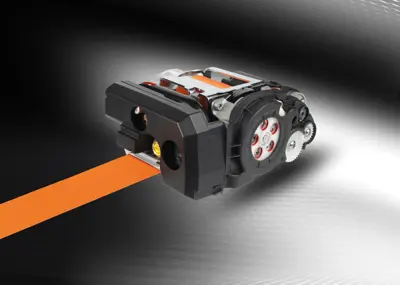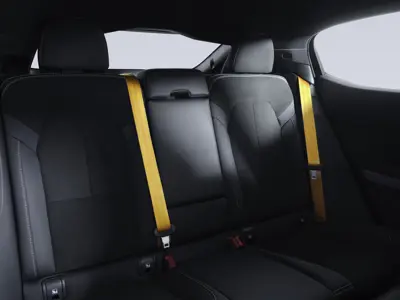Seat Belts
In electric vehicles, as in all modern cars, seat belts remain the most vital safety feature. They are designed to secure the driver and passengers of a vehicle against harmful movement that may result from a collision or a sudden stop.
Seat belts can reduce the risk of death or serious injury by about half, according to the Centers for Disease Control and Prevention.
Modern vehicles, including all EVs, use advanced three-point seat belts combined with technologies that improve protection and occupant positioning. The sections below focus on the systems you will actually find in today’s cars.
Three-Point Seat Belts
The modern three-point seat belt was invented by Volvo engineer Nils Bohlin in 1959. Volvo made the patent available to the entire automotive industry free of charge, accelerating the global adoption of this life-saving technology. The three-point design remains the foundation of today’s restraint systems because it effectively restrains both the upper and lower body while distributing crash forces across stronger skeletal regions.
Nearly all modern passenger vehicles use three-point seat belts, which combine a lap belt and a shoulder belt in one continuous loop. This design distributes crash forces across stronger areas of the body, reduces forward motion, and prevents ejection. Three-point belts form the foundation of today’s occupant protection systems and work closely with airbags, pretensioners, and load limiters.
Seat Belt Technologies
Pretensioner: Pretensioners tighten the seat belt when a crash is detected, removing slack to hold the occupant firmly in place. They significantly reduce the risk of contact with the dashboard, steering wheel, or other occupants. Pretensioners are typically located in the retractor but may also be integrated in the buckle.
Types of Pretensioners
Pyrotechnic Retractor Pretensioner (Non-Reversible):
A traditional pretensioner that uses a small explosive charge to rapidly rotate the belt reel and remove slack at the moment of impact. Because the mechanism is single-use, the assembly must be replaced after deployment. These activate only once the crash has begun.
Reversible Retractor Pretensioner:
A modern, motor-driven pretensioner capable of tightening and releasing repeatedly without replacement. When linked to ADAS systems—such as automatic emergency braking, forward collision warnings, or evasive steering support—the belt can be gently tensioned before a crash. This proactive restraint positions the occupant optimally, improves airbag performance, and reduces initial movement during impact. If the threat passes, the system relaxes the belt again to maintain comfort.
In addition to pre-crash tensioning, reversible retractors can also be used as a driver-feedback actuator. Some manufacturers use controlled “tug” or “jolt” cues via the belt to warn the driver of lane departures, inattentiveness, or other ADAS alerts. This haptic feedback is highly intuitive and reaches the driver even when audio or visual warnings might be missed.
Buckle Pretensioner:
A buckle pretensioner is a subtype of pretensioner that tightens the belt by drawing the buckle toward the occupant. This removes slack specifically in the lap belt and helps prevent submarining. Buckle pretensioners are often pyrotechnic and are commonly used in combination with retractor pretensioners to control different types of occupant movement.
Load Limiter: This feature prevents the belt from applying excessive force to the chest during a collision. It allows controlled payout of the belt or absorbs energy through a mechanical element. Load limiters work with pretensioners to balance restraint with occupant protection.
Adjustable Upper Anchor: This allows the shoulder belt height to be adjusted for comfort and proper fit, preventing the belt from rubbing against the neck or slipping off the shoulder.
Adaptive Seat Belts
A new generation of adaptive seat belts is emerging, particularly in premium EVs. These systems automatically adjust belt tension and support in real time based on driving conditions, occupant posture, and crash predictions.
Volvo’s latest multi-adaptive seat belt technology is an example of this direction. It uses more advanced control logic and enhanced actuators to fine-tune the belt’s response throughout the drive—tightening during dynamic maneuvers, optimizing occupant position for airbag deployment, and easing tension for comfort when conditions are stable.
A key advantage of adaptive belts is their ability to apply different levels of tension and load management depending on occupant size and body characteristics. Smaller occupants, for instance, may require lower peak belt forces to avoid excessive chest loading, while larger occupants may benefit from stronger tensioning to achieve optimal positioning. By tailoring belt forces dynamically, adaptive systems improve both protection and comfort across a wide range of body types.
These systems move beyond simple pretensioning, offering a more personalized and predictive form of occupant restraint.
Design and Color Options
While most seat belts have traditionally been black or dark grey, several modern manufacturers now offer colored or design-focused seat belts as optional equipment. These belts provide a visual accent in the cabin while maintaining full safety performance.
Polestar is a well-known example, offering distinctive Swedish Gold seat belts on some models to match the brand’s performance-oriented design elements. Other manufacturers also experiment with contrasting colors or stitching to give the interior a more personalized, premium appearance. These options do not impact functionality, as all belts must meet the same safety standards regardless of color.
These features enhance the safety, comfort, and personalization options of today’s three-point seat belts. Regardless of the technologies present in a vehicle, the most important factor is wearing the seat belt correctly and consistently. Seat belts save lives—but only when used properly.




